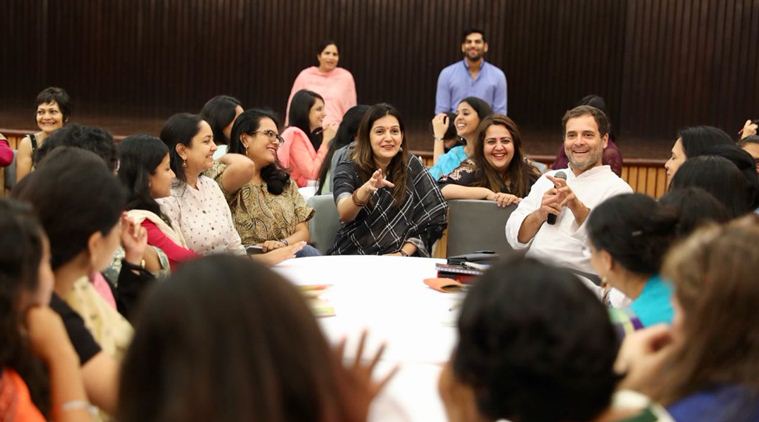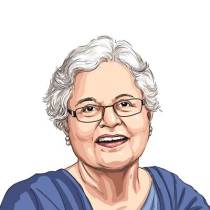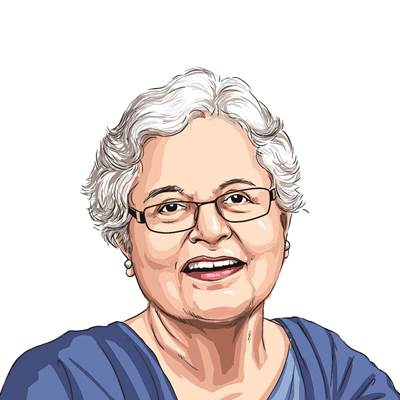Esprit de Women’s Press Corps
Curiously, those who protest self-righteously against being associated with gender-based journalist organisations have no qualms about being active members and even office-bearers of various other media bodies, in which membership is also restricted.

(Source: Twitter/@INCIndia)
Ever since the Indian Women’s Press Corps (IWPC) was founded 24 years ago, there have been occasional sneers and jeers questioning the need for a separate forum for women journalists. Last week, IWPC-baiting reached a new high in the wake of an off-the-record interaction between Rahul Gandhi and women journalists, including some elected representatives of the IWPC. Whether it was peevishness at not being included in the guest list or genuine concern about the media fraternity being divided along gender lines, the issue went viral. An article by a former woman colleague deploring the very concept of a separate body for women journalists added fuel to the fire and was picked up by several news websites, not surprisingly edited by males.
The logic of the author is that forming a separate organisation for women or holding a separate press meet for women, is tantamount to dividing the profession on gender lines. A sinister effort to segregate an already divided community. Women journalists fought hard to be recognised as equal to their male colleagues and by forming a separate organisation have turned the clock back, is her argument.
Curiously, those who protest self-righteously against being associated with gender-based journalist organisations have no qualms about being active members and even office-bearers of various other media bodies, in which membership is also restricted. Such organisations include the Editors Guild, Press Association, Foreign Correspondents Association, South Asian Women in Media and News Broadcasters Association. The guild, for instance, if seen through the same warped lens, divides the fraternity on the basis of hierarchy in the profession and in addition negates the principle of egalitarianism. (The association has a demanding standard as to who makes the cut for this elite club, leading to considerable heartburn.) And why is it kosher to be a member of the South Asian Women in Media and not the IWPC?
As one of the founding members of the IWPC, I have frequently been asked: Why the need for an IWPC when there is the Press Club of India (PCI), which is open to all? The answer is that the corps, not club as it is often mistakenly referred to, was started on a very different premise from the more jolly PCI, which was originally started as a convivial watering hole to unwind in after long hours of work. (Only recently has it become far more active on issues concerning the profession.)
The IWPC was conceived not simply as a cheap and convenient meeting place. It was to be a professional body upholding standards, providing even junior members an opportunity to interact with people in the news and organising relevant discussions. Another important objective was to act as a support group in a profession where the demanding work schedule, unconventional hours and low wages, at least in the early years when women first entered the media, put a strain on a woman journalist’s social and family life in conservative Delhi. When I joined as a reporter in the early 1970s, there was no such thing as a separate toilet for women either in my newspaper or close to the Press Gallery in Parliament. Even the PCI women’s toilet was an apology of a loo. While reporters had their scooters, women had to rely on the erratic and infrequent bus service or else blow up most of their earnings hiring autorickshaws. The neighbours wondered whether you worked in a night club, or worse, when the battered office van dropped you at 1 am and 2 am at your doorstep after night duty.
It was thanks to the support of the then prime minister, Narasimha Rao, that the IWPC was granted a home at 5 Windsor Place, despite the strong objections of the housing ministry. The building, actually pinpointed by us, was a government bungalow lying vacant for many years on the specious excuse that the roof was leaking. The apparent hole in the ceiling somehow mysteriously disappeared when we moved in. I admit shamefacedly that the IWPC delegation which called on the PM sat stony-faced when Rao’s media adviser, an old-fashioned sort, whispered to Rao that he had perhaps read about the Press Club, which was an unfit place for women. (A week earlier, the club was in the news when a real estate agent was shot there.) This was certainly not the reason we had formed the IWPC and the shooting was a one-off freak accident, but we felt that in this case discretion rather than the truth made better sense.
The other heartburn, on the issue of the women mediapersons’ interaction with Rahul Gandhi, is to question the basis on which the guest list was drawn. Cherry-picking of invitees to political events, whether anniversaries of governments, Iftaar parties, mango parties, press conferences of the high and mighty, background briefings by ministries or blacklisting of TV channels and newspapers, is part and parcel of the long-standing uneasy relationship between journalists and politicians and government. Disseminators of news are not concerned about upholding the principle of freedom of expression, but in getting favourable coverage. Those who are perceived to be hostile are not invited. The Modi government has perhaps taken black listing to a new level of autocracy. For instance, two famous news anchors are no longer to be seen on TV channels.
But politicians could perhaps argue that they too have the right to choose whom they wish to speak to. To be fair to the Congress media cell, at the recent interaction, which was incidentally meant to focus on “important issues of gender”, it displayed a refreshing degree of openness. Not only were several scribes known not to be fans of the Congress chief included, but 18 uninvited women showed up at the last minute demanding entry and were let in after displaying their PIB accreditation cards. This spirit of liberality in guest selection should serve as an example to all politicians hosting such media events in future.
The writer is consulting editor, The Indian Express
For all the latest Opinion News, download Indian Express App
More From Coomi Kapoor
- Inside Track: Hug vs slugThe photo of Rahul Gandhi’s forced hug of a stiff and stunned Prime Minister Narendra Modi in Parliament could become part of the Congress’s campaign…
- Communication gap becomes embarrassment over British LawyerMEA instructed the Indian High Commission in London to not issue him a visa. But by the time New Delhi contacted London, an e-business visa…
- Will Prashant Kishore run Modi’s 2019 campaign too?Kishor took credit for Narendra Modi’s success in the 2014 general election and Nitish Kumar’s victory in Bihar in 2015. However, he had to eat humble…







































No hay comentarios:
Publicar un comentario